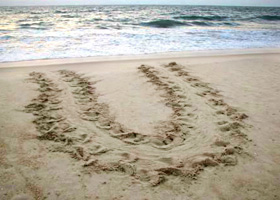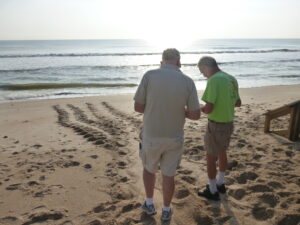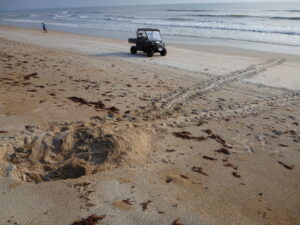![]()
Every morning from May 1 through October 31, NSB Turtle Trackers meet before sunrise to survey the beach for any signs of sea turtle nesting or hatching activity. To cover the entire area of New Smyrna Beach, our volunteers split into two teams to survey routes A & B:
Team A surveys the beach from Ponce de Leon Inlet to Hiles Blvd (A route). Since this route includes the driving beach (Ponce Inlet to 27th Ave.), surveyors must reach the last public vehicle approach by 8 am or contact Beach Safety to keep sections of the beach closed to driving. The beach cannot be opened for public driving until all sea turtle activity is documented and all nests are protected.
Team B surveys the beach from Hiles Blvd. to Canaveral National Seashore (B route). Since this route includes the most nesting, surveyors must work quickly to ensure any nests in imminent danger are relocated by 9am.
Both teams work together to survey all of New Smyrna Beach and share duties including: looking for turtle tracks from the night before, checking nests due to hatch, identifying any disturbance to sea turtle nests, checking the seaweed wrackline for washbacks, and responding to any marine animal strandings. Surveyors also report threats to sea turtle nests from human activities, such as artificial lighting and beach obstacles to FWC, Beach Safety, or Environmental Management.
Information about the different species of sea turtles that visit New Smyrna Beach can be found on the Our Sea Turtles page.
![]()
When We Find Turtle Tracks
When turtle tracks are found, we determine which direction the animal traveled (which track was incoming and which was outgoing), which species made the track, and whether the turtle nested. Sometimes the turtle crawls onto the beach but goes back to the ocean without nesting, which is called a false crawl (photo on the left). False crawls may be caused by disturbances such as bright lights or loud noises, by obstacles encountered on the beach such as furniture or seawalls, or simply due to the turtle’s personal preference for a nesting site.
If the turtle did nest, we determine the general area where the eggs are and build a barrier. If the nest is in an area that is subject to raccoon depredation, the clutch of eggs must be located so it can be screened to protect it. Likewise, if the nest is in an area that is subject to storm water runoff or is too low on the beach and would be inundated during high tides, the nest must be relocated to a safer location such as a natural dune area. Surveyors follow strict state and federal guidelines and must relocate any nests in danger of inundation or runoff by 9 am
All nests are recorded using high accuracy GPS and precise nest data is recorded.


How to Read a Nest Barrier
All nests in New Smyrna Beach are recorded and protected by a barrier constructed of 4 wooden stakes, brightly colored survey ribbon, and sea turtle nest warning signs. The yellow sign warns of fines and prosecution for anyone that harrasses or disturbs sea turtles or their nests. The blue sign offers suggestions for beach-goers on how to help reduce disturbances to nesting and hatching sea turtles.
If you look at the white stake on any nest barrier in New Smyrna Beach, you will see the nest ID number and just below that are three dates. The first is the date the nest was laid, and the next two are the hatching window. On the day the hatching window is reached, an extra “flag” stake with a pink streamer of survey tape is placed on the north side of the nest barrier.

A nest that is flagged is inspected every day for signs of hatchling emergence. When hatchlings emerge, the flag stake is moved to mark the exact location of the clutch of eggs. At least three days after the first emergence, the nest is excavated and hatching success is recorded. If five or fewer live hatchlings are found trapped in the nest, they may be released immediately. If it is after 9am, more than five hatchlings are found, or hatchlings are too weak to swim away, they may be kept until later that evening to be released. Any hatchlings that are unable to swim away are transported to the Marine Science Center for rehabilitation.



